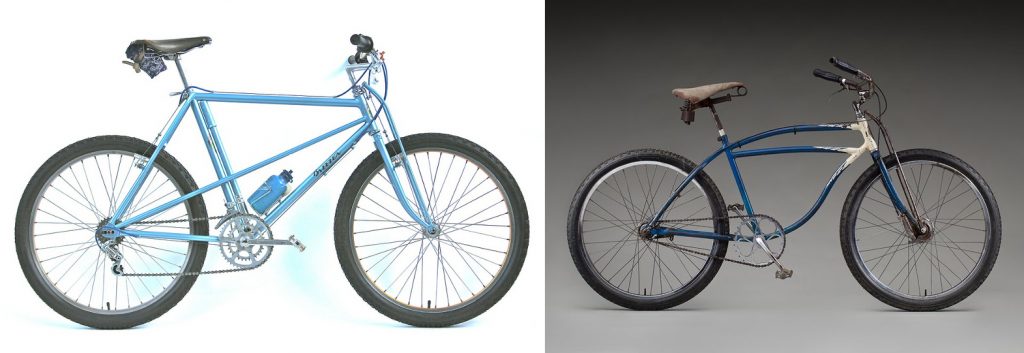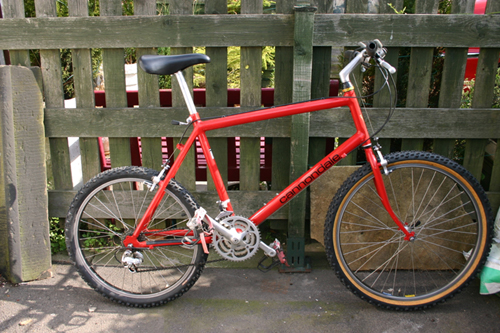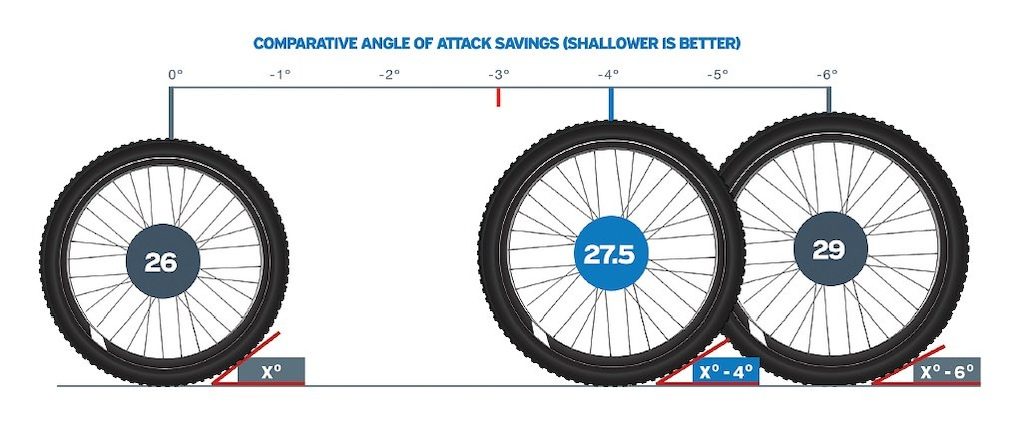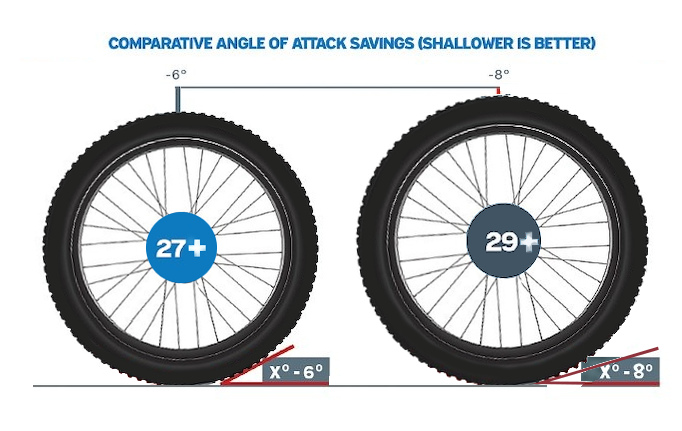by John Brown,
Here is a brief history and a look into the future of mountain bike wheel sizes. Once the 29er revolution took over, many companies started looking at even more sizes. Therefore, we now have: 24”, 26”, 27.5”, 29”, 27+ and 29+ wheel options, with another new dimension on the horizon.
The Mountain Bike began it’s commercial success in 1978 in the mountains around the San Francisco bay area. A group of friends started racing down mountain roads on trash-picked Schwinn Excelsior cruiser bikes. Quickly, riders demanded a more durable bicycle that could not only bomb down the hills, but turn around and ride back up. To that end, Joe Breeze of Breezer bikes was happy to oblige by building the first ever Mountain Bike. Considering there were only 26” balloon tires (like the ones on the Excelsior) That is what he used for the first Mountain Bike, setting the tone for all Mountain Bikes built over the next 25 years.

Breezer #1 (the first Mountain Bike) and the Schwinn Excelsior “klunker” both with 26″ wheels
Early changes to wheel sizes
By the early 90’s, mountain bikes had exploded. There were professional mountain biking events all over the world, a prime-time TV show (Pacific Blue anyone?) and mountain bikes in every garage in the country. On the wave of MTB excitement bicycle brands started investing serious money into new technology development, and one of the areas of interest was wheel size. Starting things off was Cannondale with their long heralded “Beast of the East” that used a 24” rear wheel. The benefit of a smaller wheel is better acceleration and the ability to make shorter chainstays.

Cannondale “Beast of The East” with 24″ rear wheel
On the other side of the country, in Petaluma California, a different idea was being hatched. Based on the development of the 700x48c “Rock and Road” tire by Bruce Gordon, A custom builder caller Willits, started making mountain bikes with 700c wheels. The owner of Willits, Wes Williams, was well connected within the cycling industry and became the advocate for what would be called a 29er. From Wes’ influence, Trek, the largest bike brand in the world, launched production 29ers through their Gary Fisher brand. At that point 29ers were in the main stream and now with so many wheel sizes take a look below to see the pros and cons of each size.

Rock and Road tire that was the start of the 29er movement
It all started with a 26” wheel size
The 26 inch wheels have existed for over 100 years. Furthermore, the critical dimensions of these wheels haven’t changed. Therefore, you could theoretically fit a tire from 1930 onto a rim of today. In an industry that releases new products every year, that consistency is amazing. Currently, 26” wheels are used primarily on department store Mountain Bikes or cruiser bicycles. Therefore, 26″ replacement parts can be found easily and inexpensively.
27.5” and 29” wheels
While 29ers led the way for new wheel sizes, 27.5” wheels were also popular in the initial wheel size change. The reason 29ers took hold so quickly was, in comparison to 26” wheels, they roll over objects easier and have better traction. Conversely, the downside to larger wheels is more mass to push around. In fact, The issue with mass is why 27.5” wheels became popular. A 27.5” wheel has similar traction and roll over to a 29er with much less weight. Therefore they accelerate and change direction more easily. You will now find 29” and 27.5” wheels on almost any mountain bike sold in bike shops. Typically, you see 27.5” wheels on smaller size bikes and 29” on the larger sizes. Also, full suspension bikes use 29ers on the lower travel options and 27.5” on longer travel bikes.

A fun chart Giant Bicycles released to compare wheel size and angle of attack
Plus wheel sizes
Plus sized tires are a new development in the cycling industry. In detail, they use the same rim diameter as 29″ and 27.5” bikes, but the rims and tires are wider. For example, a standard tire width is around 2”, while plus tires are 3” wide. As a result, plus sized tires puts a lot more rubber on the ground, and gives you amazing traction. With a plus sized tire, you can expect to climb up almost anything with ease. Therefore, once difficult trails become easier, and it feels as if every turn has a berm. The penalty for all that traction is additional weight. Additionally, having large tires increases the tire’s overall air volume and makes finding the right pressure a bit more complicated. If you are interested in plus tires, your bicycle has to be built to accept their additional size. Usually, it’s just best to buy a complete bike.

Plus tire angle of attack
The future wheel sizes
The development of wheel sizes has slowed down a bit for the cycling industry. With that being said, the movement has shifted to tires. The most recent buzz is coming from the 29” x 2.5” size tire. This “Big 29” tire is looking to be the new size of the year. The reason that size is getting attention is because it blends the speed and agility of a standard 29” tire with the gravity defying traction of plus tires.
What wheel size is best for You
I would love to say it’s easy to measure the pros and cons of each wheel/tire size, cross reference that information with your personal preferences and decide what is the right thing for you. Sadly, that doesn’t work. In reality, the best way to see what is going to work for you is to test ride them. Test rides are the best way to match your riding style with one of the many options available today.
